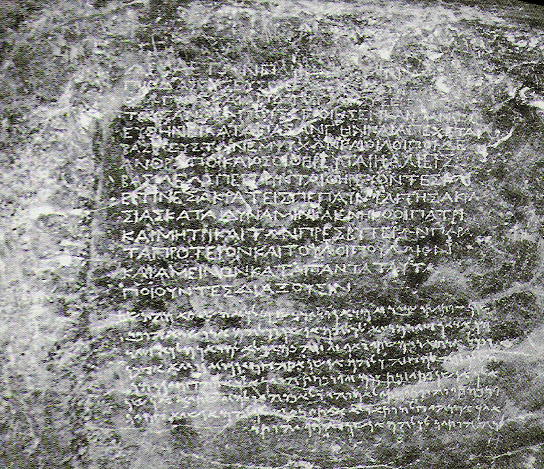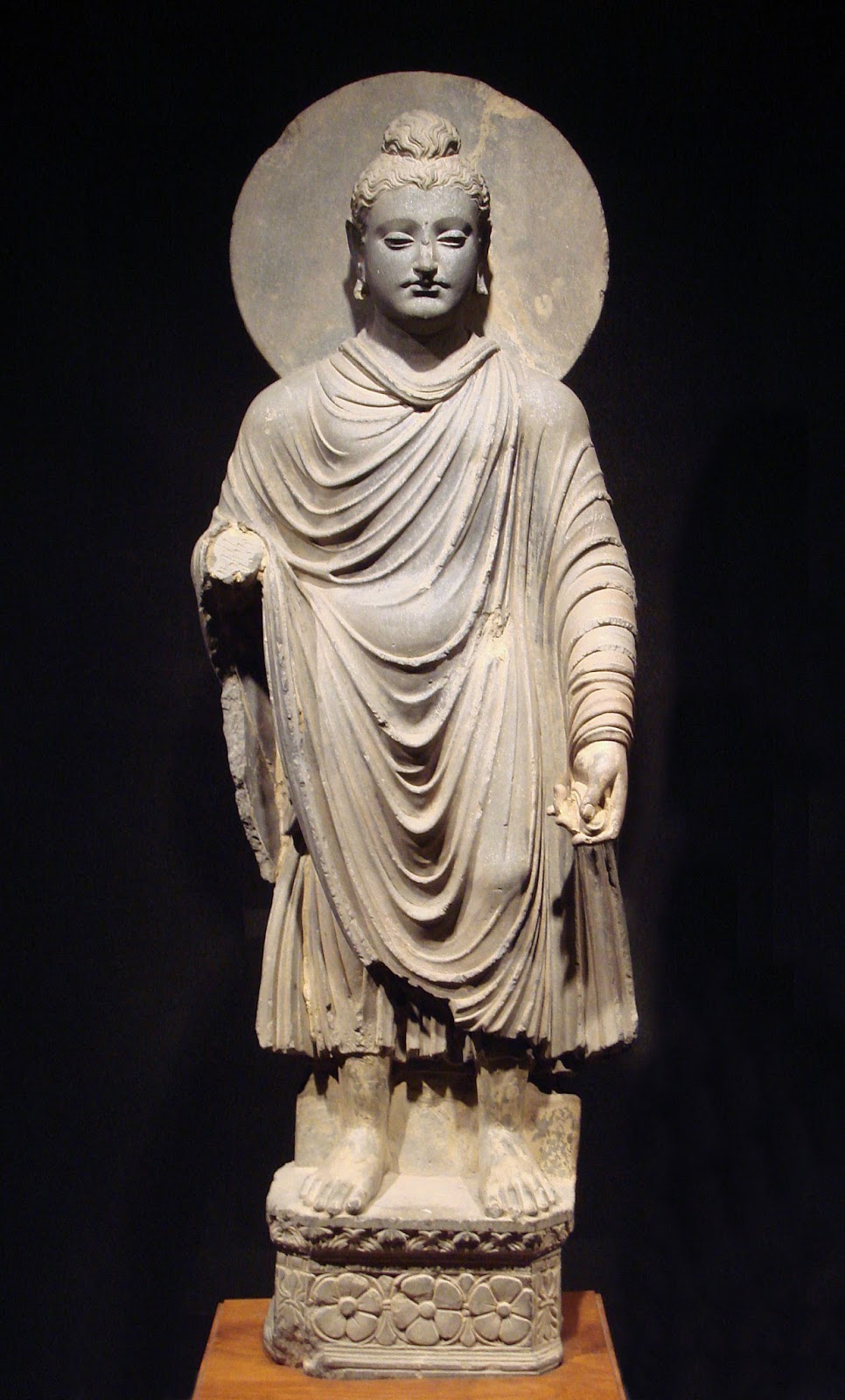
Herculean depiction of Vajrapani (right), as the protector of the Buddha, 2nd century CE Gandhara, British Museum.
Greco-Buddhism, sometimes spelled Graeco-Buddhism, refers to the cultural syncretism between Hellenistic culture and Buddhism, which developed between the 4th century BCE and the 5th century CE in Bactria and the Indian subcontinent, corresponding to the territories of modern-day Afghanistan, India, and Pakistan.
It was a cultural consequence of a long chain of interactions begun by Greek forays into India from the time of Alexander the Great, carried further by the establishment of the Indo-Greek Kingdom and extended during the flourishing of the Kushan Empire. Buddhism was then adopted in Central and Northeastern Asia from the 1st century CE, ultimately spreading to China, Korea, Japan, Philippines, Siberia, and Vietnam. (source)
General area of Greco-Buddhism, and boundaries of the Kushan empire at its greatest extent around 150 AD. The interaction between Hellenistic Greece and Buddhism started when Alexander the Great conquered Asia Minor and Central Asia in 334 BC, going as far as the Indus, thus establishing direct contact with India, the birthplace of Buddhism.
Alexander founded several cities in his new territories in the areas of the Oxus and Bactria, and Greek settlements further extended to the Khyber Pass, Gandhara (see Taxila) and the Punjab. These regions correspond to a unique geographical passageway between the Himalayas and the Hindu Kush mountains, through which most of the interaction between India and Central Asia took place, generating intense cultural exchange and trade.
Following Alexander's death on June 10, 323 BC, his Diadochi (generals) founded their own kingdoms in Asia Minor and Central Asia. General Seleucus set up the Seleucid Kingdom, which extended as far as India. Later, the Eastern part of the Seleucid Kingdom broke away to form the Greco-Bactrian Kingdom (3rd–2nd century BC), followed by the Indo-Greek Kingdom (2nd–1st century BC), and later still by the Kushan Empire (1st–3rd century AD).
The interaction of Greek and Buddhist cultures operated over several centuries until it ended in the 5th century AD with the invasions of the White Huns, and later the expansion of Islam. (source)

Bilingual edict (Greek and Aramaic) 3rd century BC by Indian Buddhist King Ashoka, see Edicts of Ashoka, from Kandahar. This edict advocates the adoption of "godliness" using the Greek term Eusebeia for Dharma. Kabul Museum.
Numerous works of Greco-Buddhist art display the intermixing of Greek and Buddhist influences, around such creation centers as Gandhara. The subject matter of Gandharan art was definitely Buddhist, while most motifs were of Western Asiatic or Hellenistic origin.
The anthropomorphic representation of the Buddha

Gautama Buddha in Greco-Buddhist style, 1st-2nd century CE, Gandhara (modern eastern Afghanistan).
Although there is still some debate, the first anthropomorphic representations of the Buddha himself are often considered a result of the Greco-Buddhist interaction. Before this innovation, Buddhist art was " aniconic": the Buddha was only represented through his symbols (an empty throne, the Bodhi tree, the Buddha's footprints, the prayer wheel).
This reluctance towards anthropomorphic representations of the Buddha, and the sophisticated development of aniconic symbols to avoid it (even in narrative scenes where other human figures would appear), seem to be connected to one of the Buddha’s sayings, reported in the Digha Nikaya, that discouraged representations of himself after the extinction of his body.
Probably not feeling bound by these restrictions, and because of "their cult of form, the Greeks were the first to attempt a sculptural representation of the Buddha" (Linssen, " Zen Living"). In many parts of the Ancient World, the Greeks did develop syncretic divinities, that could become a common religious focus for populations with different traditions: a well-known example is the syncretic God Sarapis, introduced by Ptolemy I in Egypt, which combined aspects of Greek and Egyptian Gods. In India as well, it was only natural for the Greeks to create a single common divinity by combining the image of a Greek God-King (The Sun-God Apollo, or possibly the deified founder of the Indo-Greek Kingdom, Demetrius), with the traditional attributes of the Buddha.
Many of the stylistic elements in the representations of the Buddha point to Greek influence: the Greco-Roman toga-like wavy robe covering both shoulders (more exactly, its lighter version, the Greek himation), the contrapposto stance of the upright figures (see: 1st–2nd century Gandhara standing Buddhas), the stylicized Mediterranean curly hair and top-knot apparently derived from the style of the Belvedere Apollo (330 BCE), and the measured quality of the faces, all rendered with strong artistic realism (See: Greek art). A large quantity of sculptures combining Buddhist and purely Hellenistic styles and iconography were excavated at the Gandharan site of Hadda. The 'curly hair' of Buddha is described in the famous list of 32 external characteristics of a Great Being (mahapurusa) that we find all along the Buddhist sutras. The curly hair, with the curls turning to the right is first described in the Pali canon of the Smaller Vehicle of Buddhism; we find the same description in e.g. the "Dasasahasrika Prajnaparamita".
Greek artists were most probably the authors of these early representations of the Buddha, in particular the standing statues, which display "a realistic treatment of the folds and on some even a hint of modelled volume that characterizes the best Greek work. This is Classical or Hellenistic Greek, not archaizing Greek transmitted by Persia or Bactria, nor distinctively Roman" (Boardman).
The Greek stylistic influence on the representation of the Buddha, through its idealistic realism, also permitted a very accessible, understandable and attractive visualization of the ultimate state of enlightenment described by Buddhism, allowing it reach a wider audience: "One of the distinguishing features of the Gandharan school of art that emerged in north-west India is that it has been clearly influenced by the naturalism of the Classical Greek style. Thus, while these images still convey the inner peace that results from putting the Buddha's doctrine into practice, they also give us an impression of people who walked and talked, etc. and slept much as we do. I feel this is very important. These figures are inspiring because they do not only depict the goal, but also the sense that people like us can achieve it if we try" (The Dalai Lama, foreword to "Echoes of Alexander the Great", 2000).
During the following centuries, this anthropomorphic representation of the Buddha defined the canon of Buddhist art, but progressively evolved to incorporate more Indian and Asian elements. (source)
Related:
- The 10 Most Famous Personalities Of The Last 6,000 Years
- Top 14 Greatest Philosophers And Their Books
- DNA Reveals Origin of Crete’s Ancient Minoan People
- 30 Precious Life Lessons By 10 Ancient Greek Philosophers
- The Key To Happiness, According To 3 Greek Philosophers
- Ancient Greeks discovered America, according to an Italian university professor
- This Mysterious 2,100-Year-Old Mechanism Is the World’s First Computer
- Unbelievable inventions by ancient Greeks that remained unexplained until the 20th century
- How To Build A Fake Ancient City In Just 5 Years
- One Buddha Teaching That Will Tell You More About Yourself Than Anything Else
- The Four Types Of Friends According To The Buddha
- 25 Life Changing Lessons to Learn from Buddha
- 8 Ancient Beliefs Now Backed By Modern Science
- 10 Unexplained Similarities between Ancient Cultures
- 10 Mind-Blowing Theories That Will Change Your Perception of the World
- The 10 Most Puzzling Ancient Artifacts
- Why Does Ancient Art Contain Depictions Of Flying Aircraft, Helicopters And Dinosaurs?
- This precious secret had been concealed for 3.245 years. When it was finally revealed, it caused amazement and fear...
- Scientists Discovered the Egyptian Secret to Moving Huge Pyramid Stones











COMMENTS